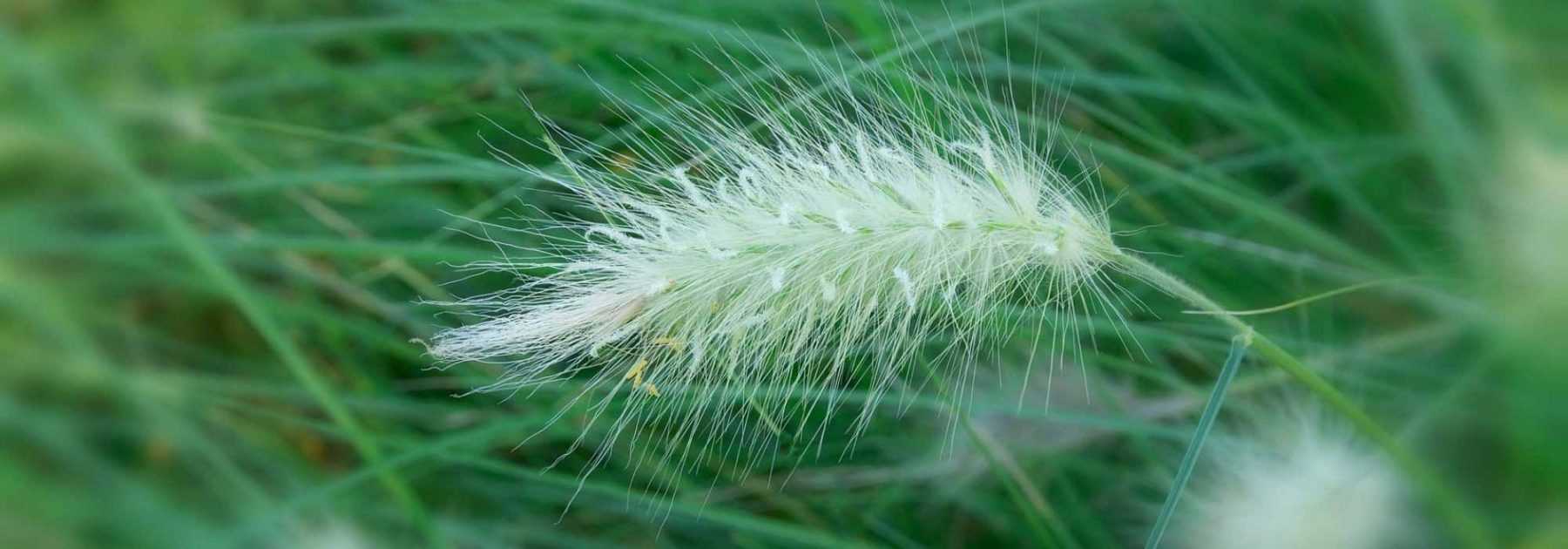
Pennisetum - Fountain Grass: Planting, Pruning, Care
Contents
Pennisetum in a few words
- The Pennisetum stands out with its attractive flowering in the form of fluffy bottlebrush plumes
- Its fine foliage, of infinite lightness, remains graphic even when dry throughout the off-season
- This is a robust grass, often very hardy, tolerant of soil, sea spray and drought
- Once well-rooted in light, well-drained soil, it requires almost no maintenance
- Versatile, Pennisetum is essential in borders, rockeries and also in flowering containers
Our expert's word
The Pennisetum is a highly fashionable ornamental grass also nicknamed “Fountain Grass” due to the cylindrical shape of its fluffy spikes. It is widely used by landscape designers to bring movement, naturalness and luminosity to the garden.
This hardy perennial and most often fully hardy plant is sought after for the beauty of its summer or autumn flowering rising above the swaying mass of fine foliage that remains graphic throughout the off-season. The show continues, even in winter when hoar frost or rime covers the culms.
Its quivering silhouette in light masses that undulate at the slightest breeze, then becomes magnificent when covered in frost, is essential to bring to all gardens, from the most naturalistic to the most contemporary, a both wild and structural aspect.
Whether it’s Pennisetum alopecuroides, Pennisetum orientale or Pennisetum setaceum, “Fountain Grass” is an easy-care grass suitable for all beginner gardeners. Extremely easy to grow, undemanding regarding soil, perfectly adapted to sea spray and drought, it excels in borders, rock gardens, along pathways but also in flowering containers.
Choose from our unique collection your Pennisetum or “Fountain Grass”, this original grass very much in vogue in recent years in all dry gardens!
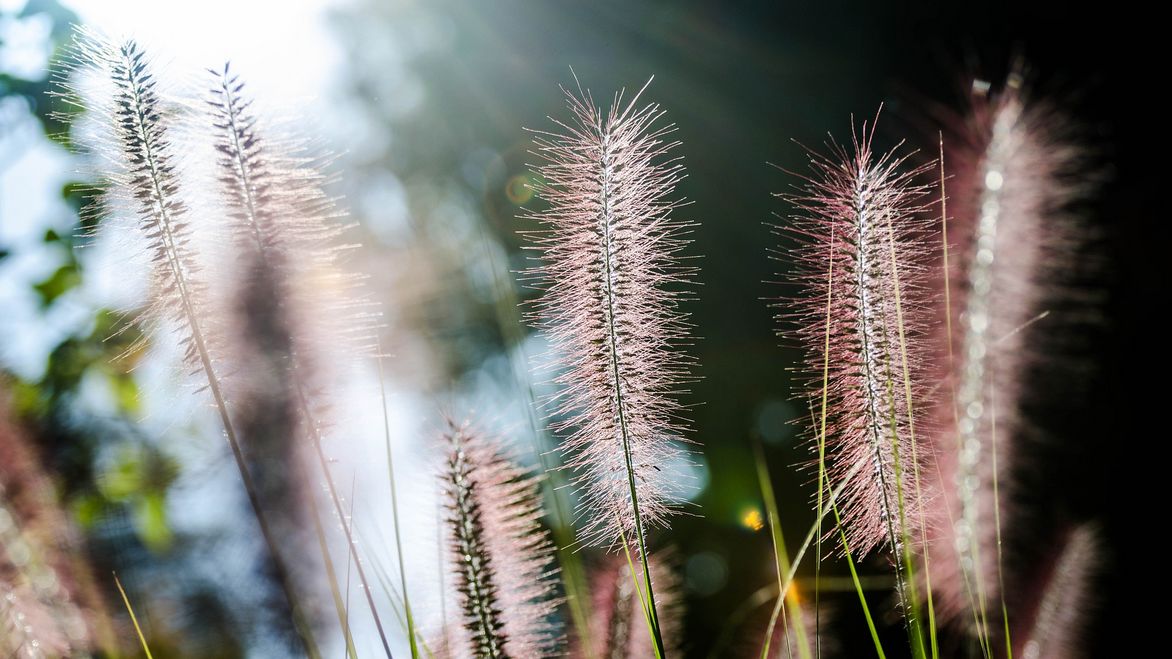
Play of light in the inflorescences of a Pennisetum
Description and botany
Botanical data
- Latin name Pennisetum
- Family Poaceae
- Common name Fountain Grass
- Flowering June to December
- Height 0.15 to 1.80 m
- Exposure Sun, partial shade
- Soil type All types, well-drained
- Hardiness -5°C to -25°C
The genus Pennisetum comprises approximately 80 species of annual or perennial grasses from the Poaceae family, native to forests and savannas of tropical and warm temperate regions, particularly Africa and Asia.
Nicknamed by some as “Fountain Grass”, its name derives from Latin meaning “feather” and “bristle”, referring to its feathery spike inflorescences resembling small bottle brushes.
Although perennial and hardy in most of our climates, some more tender species are grown as annuals in cooler regions. Pennisetum alopecuroides is the most widespread species in our gardens, also the hardiest (-25°C) and the only one to tolerate the most varied growing conditions. It comes in numerous cultivars like ‘Little Bunny’.
We also find Pennisetum incomptum, very hardy and tolerant of soil conditions, sea spray and drought, making it an excellent solution for landscaping difficult areas and dry slopes.
Most commonly grown as annuals or in pots are Pennisetum villosum and Pennisetum setaceum, hardy down to -5-10°C in good, light, well-drained garden soil. Reaching 1.80 m in height, Pennisetum macrourum is one of the tallest in the genus and better suited to large spaces.
This is a clump-forming grass that doesn’t spread by its roots: all stems emerge from the base. Non-invasive, it forms a very compact, bushy clump reaching 0.15 cm to 1.80 m in height when flowering, with nearly equal spread. Some species like Pennisetum setaceum can become invasive in mild climates and are now banned from sale as they’re considered invasive and difficult to contain.


Pennisetum varieties display inflorescences of different shapes and colours: Pennisetum alocuperoides ‘Karley Rose’, Pennisetum macourum, Pennisetum alocuperoides ‘Moudry’, Pennisetum orientale ‘Tall Tails’, Pennisetum setaceum ‘Rubrum’.
Pennisetum or “Fountain Grass” forms an upright, arching clump with a somewhat loose habit, more or less spreading, both very supple and very dense.
The deciduous or evergreen foliage in warm regions forms a fountain of very fine, linear leaves, trailing, rough and slightly sharp-edged, flat or ribbon-like. Ranging from 8 to 60 cm long, they’re light green to dark green, sometimes variegated with green, pink and purple-red (‘Rubrum’). The foliage is often marcescent, drying but persisting through winter, turning a beautiful straw-yellow colour or fiery red and orange hues in autumn.
From this gramineous vegetation, floriferous culms emerge proudly in summer or autumn, from June to December, depending on species and variety. Pennisetum produces long, silky spikelets 8 to 40 cm long grouped in feathery panicles, cylindrical or nearly spherical that sometimes bend under their own weight. These characteristic inflorescences gathered in bottlebrush-like clusters covered with long, very soft hairs inevitably evoke bottle brushes, hence its nickname, or large silky caterpillars, or even the fluffy tail of a rabbit.


Some varieties offer decorative foliage and beautiful autumn colours: Pennisetum setaceum ‘Skyrocket’, Pennisetum setaceum ‘Rubrum’, Pennisetum alocuperoides ‘Hameln Gold’, Pennisetum alocuperoides ‘Hameln’, Pennisetum setaceum ‘Fireworks’.
These airy bottlebrushes come in cream to silvery colours, green-white in spring then pale brown to purple at maturity, yellow-bronze, black-brown (Pennisetum alopecuroides ‘Moudry’), beige-pink or even purplish-pink (Pennisetum orientale ‘Karley Rose’), sometimes topped with a white tuft (Pennisetum alopecuroides ‘Japonicum’), beautifully highlighted by morning dew.
Once faded, these light spikes remain elegant throughout the winter months, drying in autumn to russet blond tones and becoming frosted in winter. They make lovely additions to both fresh and dried bouquets.
The Pennisetum is a very easy-care perennial grass, undemanding, frugal and hardy (sometimes down to -25°C in well-drained soil) practically everywhere in France. Less hardy Pennisetum varieties are often grown as annuals in summer beds or containers.
It thrives in warm, sunny positions and prefers dry, light, well-drained soils, not too heavy. It tolerates sea spray very well in coastal gardens exposed to winds.
Essential and versatile, pennisetum works well in rock gardens, flower beds, along path edges, in scree gardens, wild or contemporary-style gardens, to which it adds lightness and movement with its elegant, refined appearance. It also excels in flowering containers. Some species can also be used as ground cover or to stabilise dry slopes.
Read also
Planting ornamental grassesMain species and varieties
The pennisetum is a very trendy ornamental grass with numerous species and varieties, most of which are quite hardy like Pennisetum alopecuroides and P. incomptum (-25°C). Some pennisetums, such as P. setaceum and its hybrids along with P. villosum, are not hardy at all (-5°C to -10°C) and are most often used as annual plants in summer containers, like the well-known Pennisetum setaceum ‘Rubrum’, the most popular of annual pennisetums.
While Pennisetum alopecuroides tends to self-seed without becoming invasive, Pennisetum setaceum, considered invasive, was recently banned from being introduced, cultivated, sold or used. However, its cultivars are not affected.
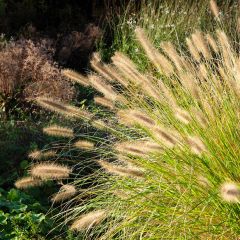
Pennisetum alopecuroides Hameln - Chinese Fountain Grass
- Flowering time October, November
- Height at maturity 50 cm
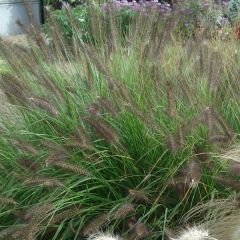
Pennisetum alopecuroïdes Moudry - Chinese Fountain Grass
- Flowering time September to November
- Height at maturity 80 cm
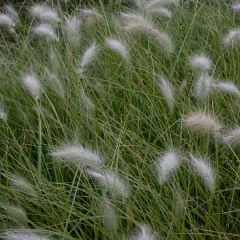
Pennisetum villosum
- Flowering time September to November
- Height at maturity 70 cm
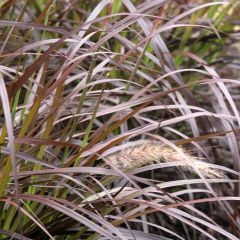
Pennisetum advena Rubrum - Purple Fountain Grass
- Flowering time August to November
- Height at maturity 1 m
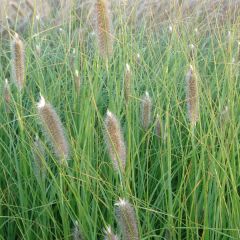
Pennisetum alopecuroïdes Japonicum - Chinese Fountain Grass
- Flowering time September to November
- Height at maturity 1,50 m
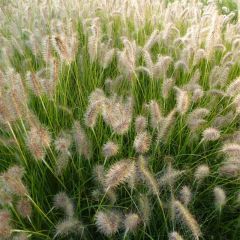
Pennisetum alopecuroides Goldstrich - Chinese Fountain Grass
- Flowering time August to November
- Height at maturity 60 cm

Pennisetum macrourum - African feather Grass
- Flowering time September to December
- Height at maturity 1,80 m
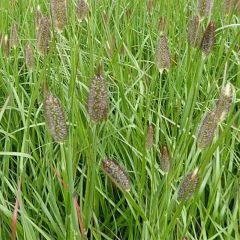
Pennisetum massaicum Red Bunny Tail - African feather Grass
- Flowering time August to October
- Height at maturity 80 cm
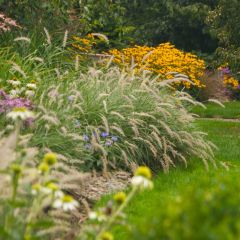
Pennisetum orientale Shogun - Oriental Fountain Grass
- Flowering time August to November
- Height at maturity 90 cm
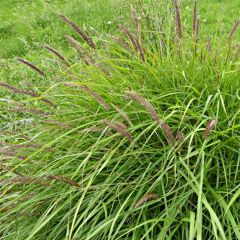
Pennisetum incomptum
- Flowering time July to November
- Height at maturity 1,10 m
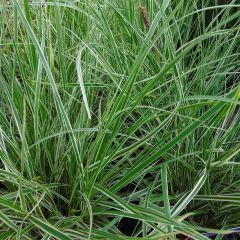
Pennisetum setaceum Skyrocket
- Flowering time August to November
- Height at maturity 80 cm
Discover other Pennisetum
View all →Available in 1 sizes
Available in 3 sizes
Available in 2 sizes
Available in 1 sizes
Available in 5 sizes
Available in 2 sizes
Available in 3 sizes
Available in 3 sizes
Available in 2 sizes
Available in 1 sizes
Planting
Where to Plant Pennisetum or “Fountain Grass”
The Pennisetum is a sturdy ornamental grass that is hardy in most of our regions. While Pennisetum alopecuroides is the most resilient of all (it withstands -25°C in well-drained soil), the foliage of certain species proves more tender, and some like P. villosum, P. setaceum will be grown as annuals or in containers to protect from cold in harsh winter climates.
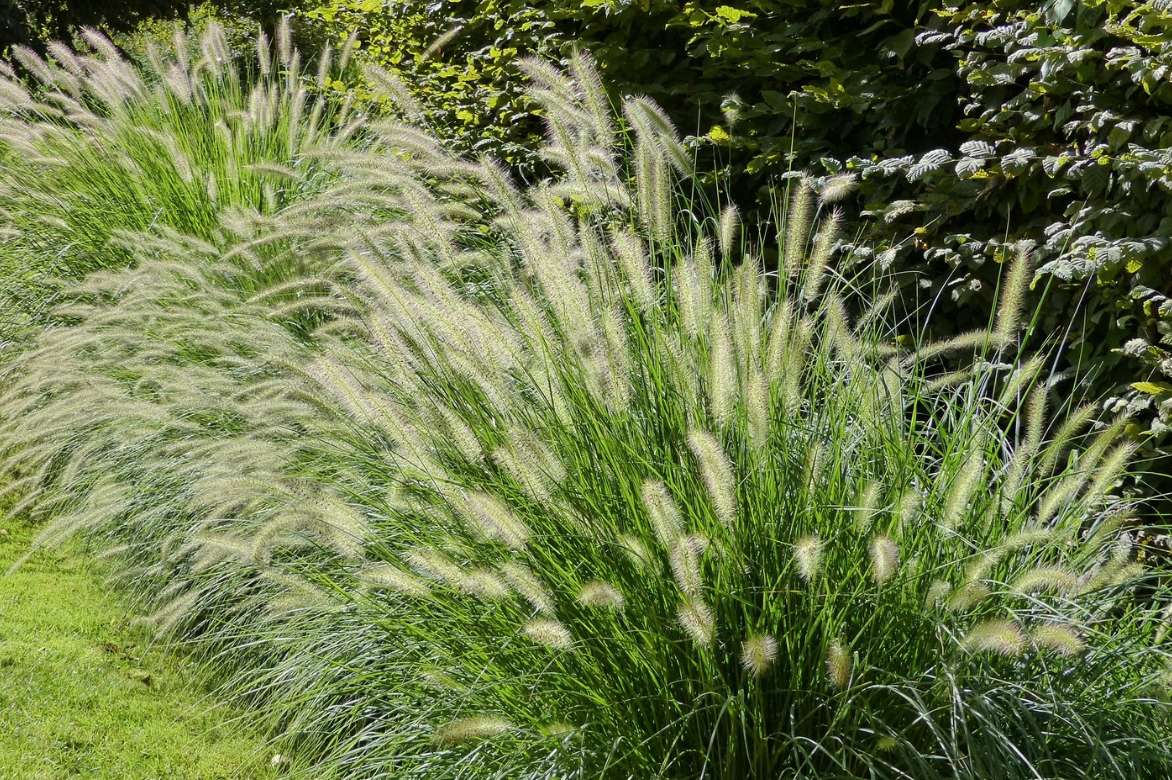
Border of Pennisetum alopecuroides
It is drought-resistant and unfazed by sea spray or wind. With its coastal character, a seaside garden exposed to sea spray will suit it perfectly.
It particularly thrives in full sun, or possibly partial shade in hot climates, in an open position, and its undemanding nature appreciates dry, light, very well-draining soils, even sandy or chalky ones. Not being a fussy perennial, Pennisetum will tolerate almost any soil type except overly heavy soils that retain moisture and suffocate its roots.
With its graphic and airy silhouette, it makes its mark in all wild and naturalistic gardens, in a flowering meadow, in a dry or gravel garden as well as in the most contemporary spaces where it enhances perspectives, even in the smallest gardens: this non-invasive plant, with its clump-forming stump, creates a neat, always impeccable tuft that doesn’t spread.
Its feathery spikes and infinitely light foliage blend into all settings, on slopes, in a large dry rockery, sun-baked borders, entryway surroundings, always bringing breath, movement and delicacy.
The tallest varieties are planted in mid or back borders, lending them a soft, quivering texture, while shorter varieties can be placed along pathways, in containers or planters on the terrace, or serve as an excellent groundcover solution for challenging areas, to stabilise dry slopes: the Pennisetum helps reduce erosion thanks to its dense root system.
When to Plant Pennisetum or “Fountain Grass”
Planting Pennisetum can be done in spring from March to June or in autumn during September-October, avoiding periods of severe frost or intense heat.
How to Plant Pennisetum or “Fountain Grass”
In the ground
For a quick impact in borders, plant at least 5 to 7 plants per m². You can also plant en masse, in tight rows (30–40 cm apart) to create a low hedge or a light pathway edging.
If your soil is heavy, add a spadeful of gravel, some compost or even river sand: Pennisetum loves light soils with good drainage.
- Plant Pennisetum in a 20 cm-wide planting hole
- Loosen the excavated soil well
- In heavy or very moist soil, spread a layer of gravel at the bottom of the hole
- Avoid planting too deeply
- Place the bucket in the centre, covering the root ball with 3 cm of soil. Firm and water thoroughly
- Water if needed once or twice every fortnight to aid establishment
Planting Pennisetum in a Pot
- Improve drainage with gravel, coarse sand or a pebble mix
- In a large terracotta pot (minimum 50 cm diameter), add the drainage layer
- Plant in a light soil mix enriched with compost and coarse river sand
- Water after planting, then regularly
- Place your container in full sun
→ Learn more about growing Pennisetum in pots in our guide!
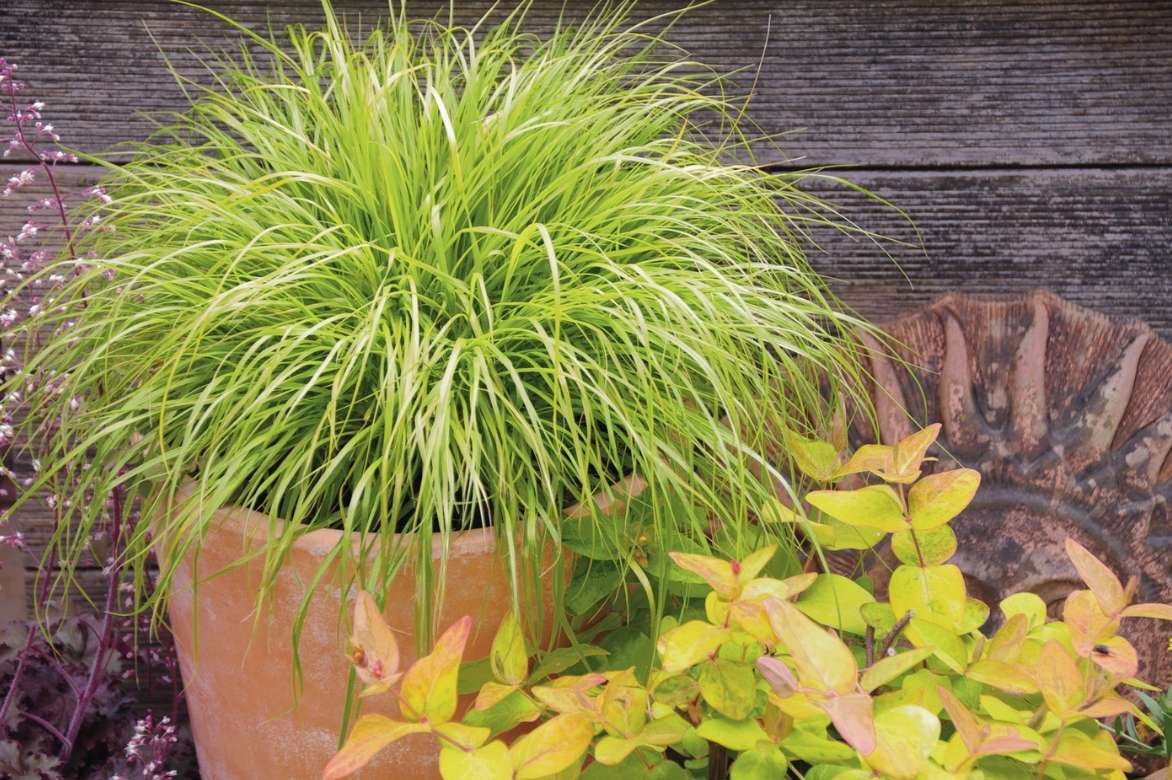

Pennisetum adapts well to container growing. Here, Pennisetum alocuperoides ‘Hameln Gold’ with its luminous foliage.
Read also
Cutting back ornamental grassesMaintenance, pruning and care
Once well established, the Pennisetum requires little maintenance. It’s the perfect plant for weekend gardens! Once properly rooted, it proves quite drought-resistant: water during extreme heat or prolonged dry spells, as it prefers relatively cool soil in summer.
In regions with very cold winters, spread an organic mulch (linseed pale, dry leaves…) around the stump to protect the plant from frost.
In poor soils, you may add a handful of well-rotted compost in spring. Potted Pennisetums will appreciate some organic fertiliser once a year in late winter.
Leave the faded inflorescences standing: in winter, they will shine under the frost.
In February-March, simply cut back the dried culms to 10 cm from the soil using hedge shears to make way for new foliage.
→ Learn more about pruning Pennisetums: when and how? with our tutorial!
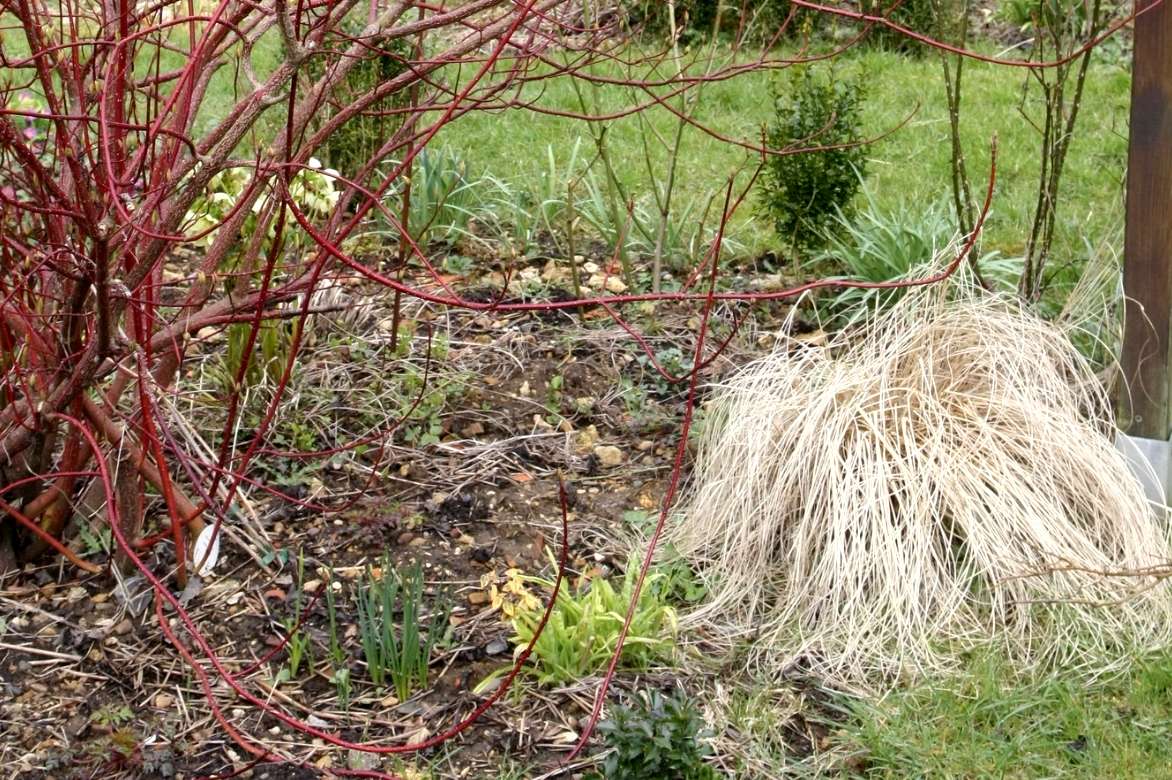
In late winter, cut back Pennisetum clumps
In well-drained soil, the Pennisetum is disease-resistant.
Dividing Pennisetum clumps
Dividing clumps of Pennisetum in spring remains the simplest method. It should be done when the plant is well-rooted, after 3 to 4 years of cultivation. In mild climates, some species self-seed naturally.
- From March onwards, carefully lift the clump using a garden fork
- Place two spades back-to-back in the centre of the clump and use one as a lever to lift
- Take some vigorous offsets
- Replant the offsets immediately in well-prepared soil
- Water thoroughly
Pairing pennisetum
The play of light through and within the foliage, the infinite lightness of the leaves, the delicate grace of the spikelets with their wild beauty, the flowers of Pennisetum that sway with the slightest breeze, suit so well all gardens, large or small, urban, countryside or coastal.
Versatile, this vigorous grass will look magnificent in a wild garden, in the refined and elegant scenes of a contemporary garden and graphic, in a dry or gravel garden, with a quivering poetry in naturalistic prairies or borders with other summer-flowering perennials, among the stones of a large rockery, as ground cover or mixed in a colourful mixed border, planted en masse along pathways, or in flowering containers.
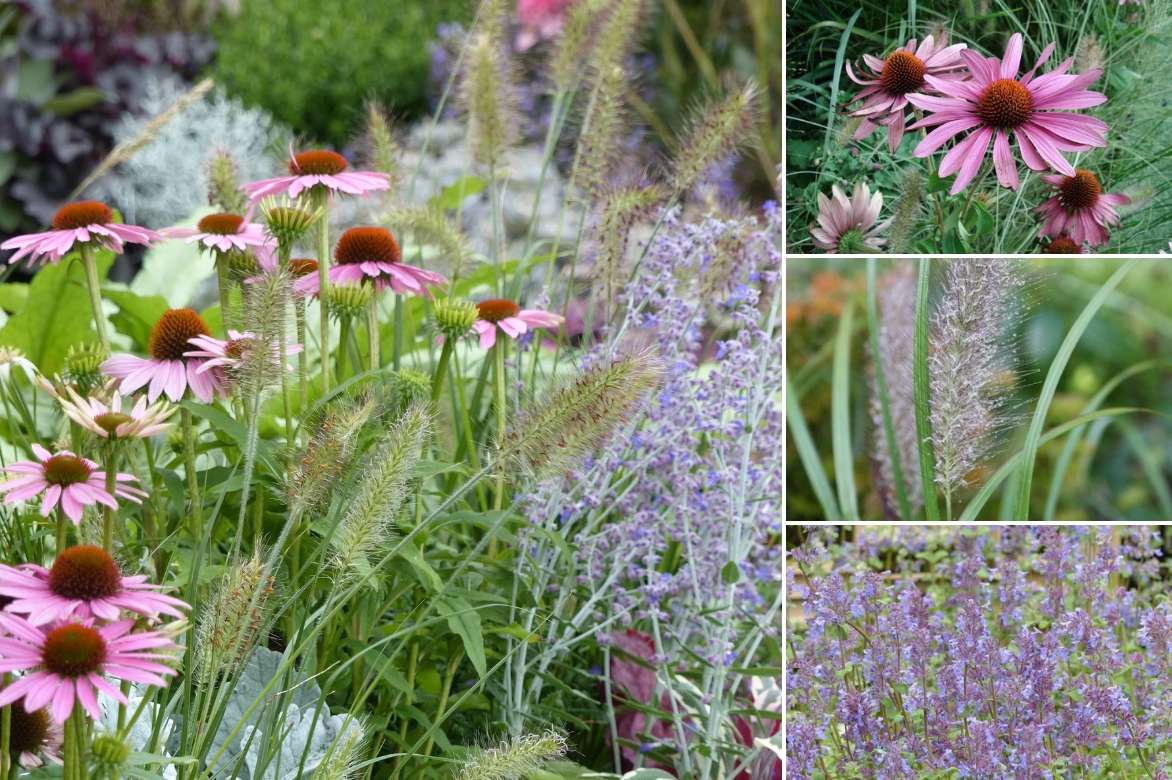

A natural pairing idea: Pennisetum alopecuroides ‘Hameln’, Echinacea purpurea and Nepeta faassenii ‘Six Hill’s Giant’.
Ethereal, it brings softness, lightness, and movement to all settings, highlighting all perspectives with transparency and adding a vibrant and poetic touch in the heart of summer.
Easy to pair, its elegant foliage tempers bold colours and acts as a setting for many perennials, bringing them light, breath, and volume.
In a lush, countryside-inspired border, pair it with wandering plants like lavender, yarrow, gaura, and eupatorium, or with tall perennials such as sage or Verbena bonariensis. It will soften the somewhat stiff habit of dahlias, large thistles, red hot pokers, or Russian sage.
For scenes of dazzling finesse and lightness, Pennisetum can be paired with golden spikes of grasses like Calamagrostis brachytricha or Diamond Grass, or Tufted Hair Grass.
In a mixed border, it will add flexibility to the sunny blooms of coreopsis, coneflowers, or sneezeweed.
In a more modern style, pair fountain grass with other ornamental grasses, tall wild grasses like Miscanthus, pampas grass, with alliums, or knotweed. It is often used in front gardens, close to the house, in modern, mineral-style borders, surrounded by white pebbles or gravel and two or three boxwood balls.
Along pathways, pair it with perennials with summer or autumn flowering like hybrid mullein, autumn daisies, hardy chrysanthemums, Virginia speedwell, shrubby sage, with heather shrubs, or asters.
In a rockery, fountain grass will pair perfectly with autumn stonecrop.
A backdrop of dark, evergreen foliage (dwarf conifers, laurustinus, oleaster) will beautifully highlight its white, cottony inflorescences.
In a white garden, it can be paired with hydrangeas, dwarf roses, fireweed, burnet, Japanese anemones, dusty miller, arborescent wormwood, or silver-leaved buddleias (‘Silver Anniversary’).
In a container, it can mingle in a frenzy of colours with tender or annual flowers like petunias, begonias, or with cosmos, love-in-a-mist, African daisies, and lantanas.
Useful resources
- Discover our tutorial to learn how to divide Pennisetum
- Incorporate ornamental grasses into a naturalistic meadow!
- Graphic and airy, our ornamental grasses are essential for creating contemporary garden scenes
- Design a graphic garden by focusing on Pennisetum!
- Get inspired with all our advice on ornamental grasses
- Discover Christine’s article about plume-like panicles
- Discover 5 ornamental grasses with variegated foliage
- Pennisetum: the best varieties for pots
- Subscribe!
- Contents
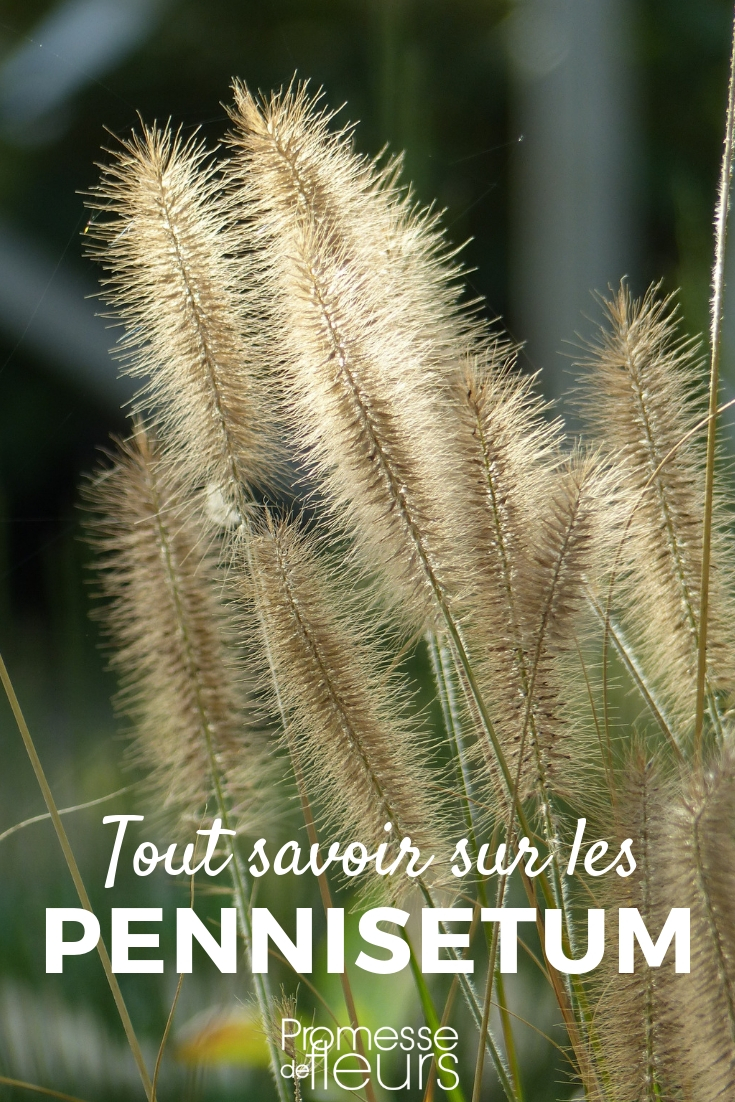


































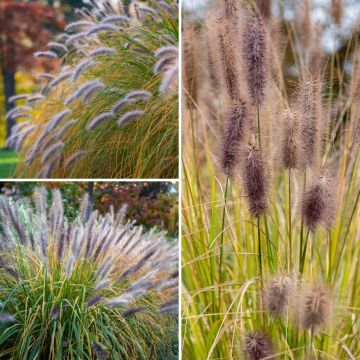


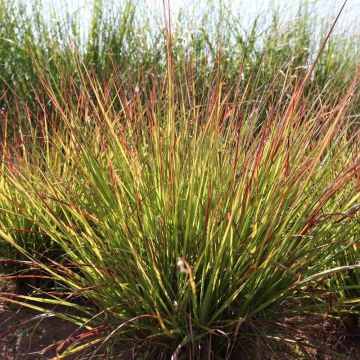

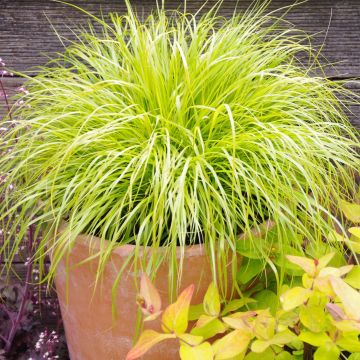
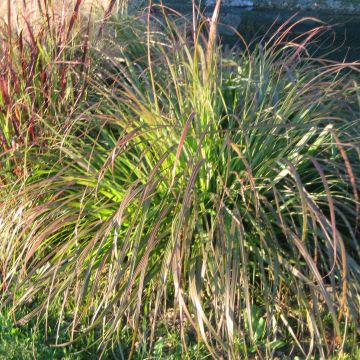
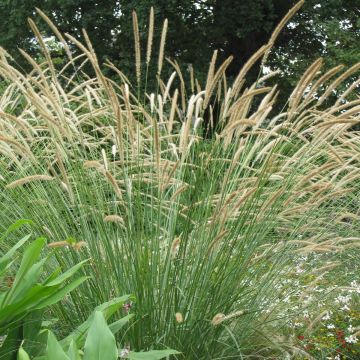
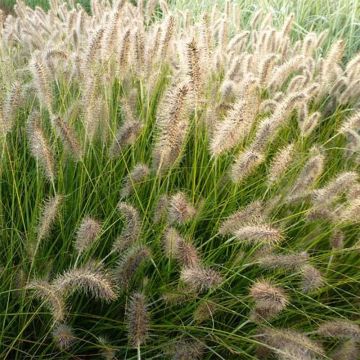

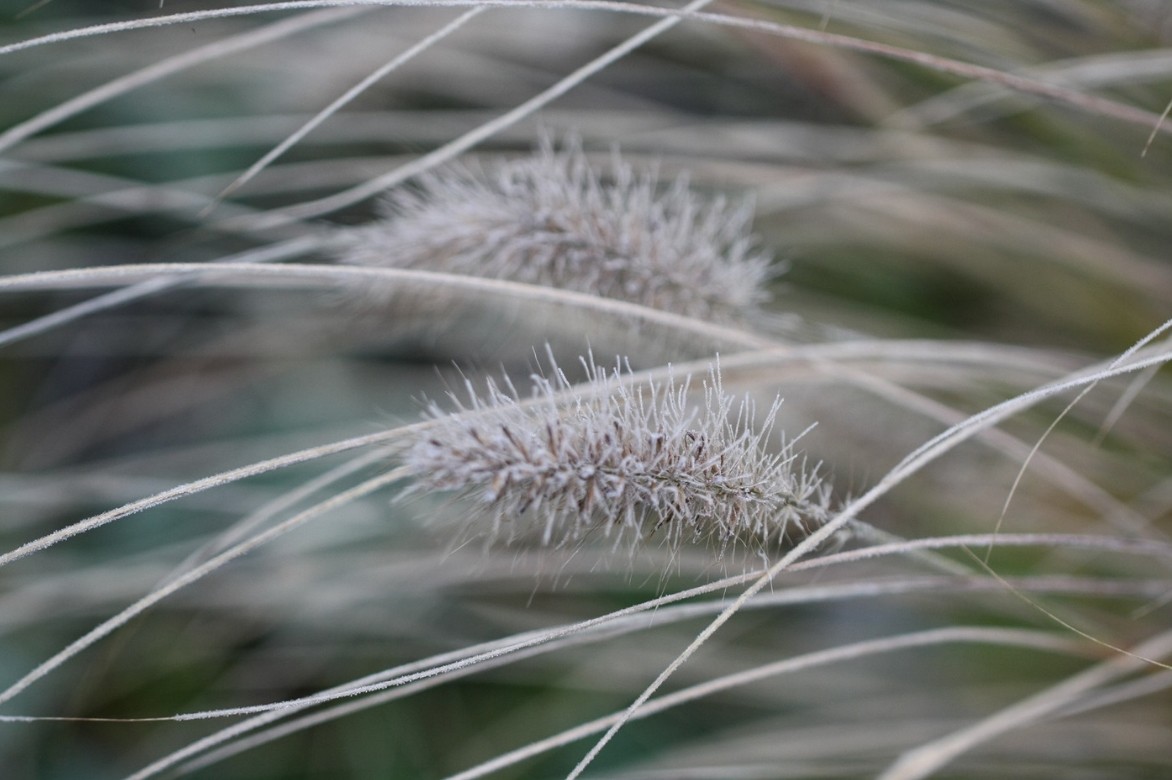
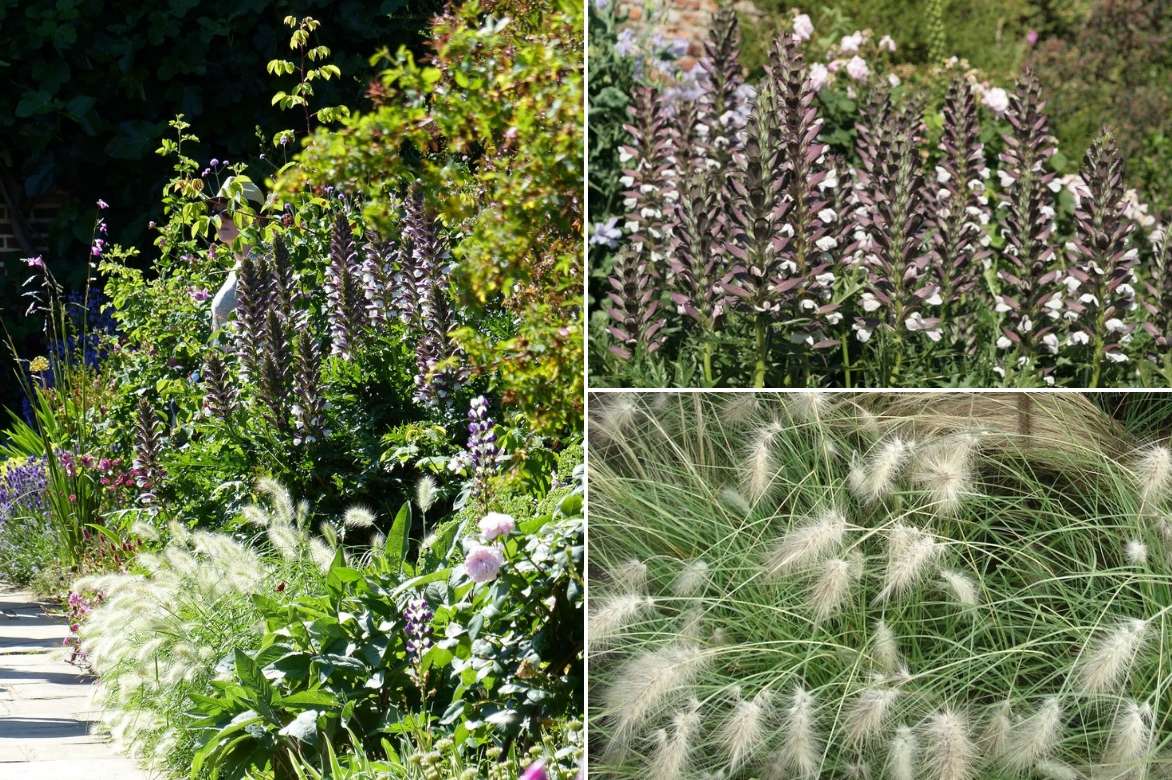
Comments